Multilingual Mathematics
Jordi Saludes
Universitat Politècnica de Catalunya
3d GF Summer Course
Fraueninsel, August 2013
Presenter Notes
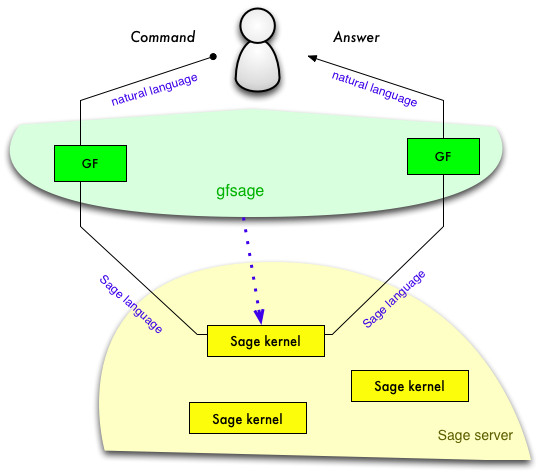 |
Steps
|
Presenter Notes
How it started?
-
With the webALT project:

-
Aiming at providing a multilingual repository of simple math exercises for secondary education.
-
GF the chosen tool
Presenter Notes
Structure
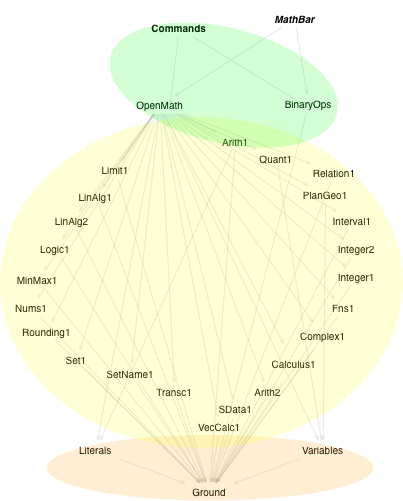
Presenter Notes
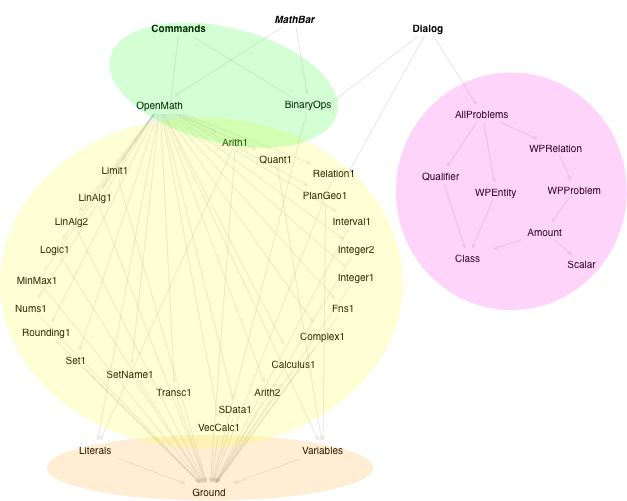
Presenter Notes
Layers
The library is organized in 3 layers of increasing complexity:
- Ground: For literal integers and variables
- OpenMath: For OpenMath objects
- Operations: Problems, verbalizations, ...
Presenter Notes

Presenter Notes
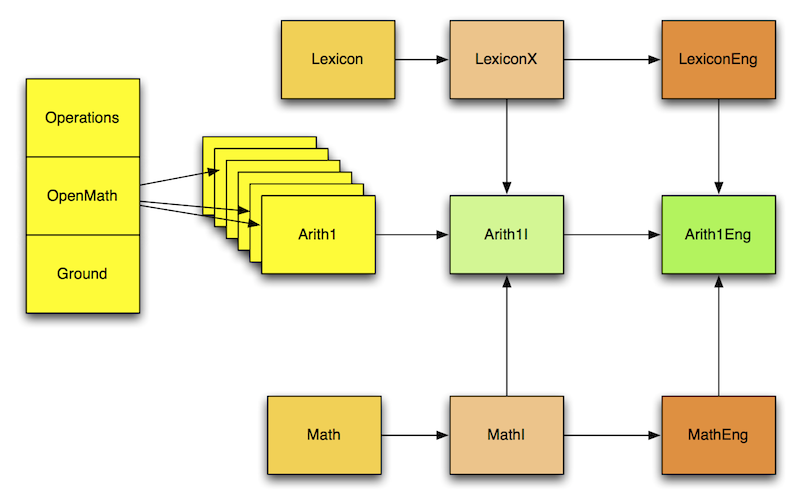
Presenter Notes
Other upper layers
-
Operations: Simple drills.
-
Commands: Queries/Answers to/from a Computer Algebra System.
-
Word Problems: Modeling and solving simple word problems.
Presenter Notes
Some examples
-
At OpenMath level:
abs : ValNum -> ValNum ; -- the absolute value of z times : [ValNum] -> ValNum ; -- the product of x, y and z unary_minus : ValNum -> ValNum ; -- minus x -
At Commands level:
Compute : (k: Kind) -> Value k -> Command ; Assign : (k: Kind) -> Variable k -> Value k -> Command ; Assert : Prop -> Command ; Approximate : ValNum -> Command ; BeginBlock : String -> Command ; EndBlock : String -> Command ;
Goal: Dependent types all the way down.
Presenter Notes
Abstract/Concrete types
-
Values:
ValNum,ValSet,ValTensor... = Noun Phrase (NP)ValFun=MathFunc=NP+ Extra info
-
Variables:
VarNum,VarSet, ... =Symbol
Goal: Value Number, Variable Number, ...
Presenter Notes
Concrete differences
-
In English:
oper abs_value_CN : CN = mkCN absolute_A value_N ; -- In LexiconEng lin abs obj = mkNP the_Art (mkCN abs_value_CN (mkAdv possess_Prep obj)) ; -- In Arith1I unary_minus ob = mkNP (mkCN minus_N ob) ; -
In Finnish:
unary_minus x = mkNP (E.GenNP x) (mkN "vastaluku") ; -
In Sage:
unary_minus x = mkPrec 1 ("-" ++ (usePrec 3 x));
Presenter Notes
Associative operators
fun plus : [ValNum] -> ValNum
lin plus : ListNP -> NP
DefGenCN sum_CN (mkNP and_Conj terms)
-
Lists are formed by prepending an object to an existing list (
ConsNP). -
ListNPis basically a list ofNPwhich knows if there is 2 or more elements in it:- "the sum of x and y":
BaseValNum x y - "the sum of x, y and z":
ConsValNum x (BaseValNum y z)
- "the sum of x and y":
-
We combine
ListNPwith the "and" conjunction to get a newNP
Presenter Notes
The case of functions
oper
MathFunc = {t:FuncForm; s2:MathVar} ** NP ;
param
FuncForm = FNoVar | FNamed | FVar | FGral ;
- Named function
- "the cosine of 3"
- Function variable
- "\(f\) at 3"
-
General case
- "the derivative of the sine at 3"
-
Lambda abstraction
- "x to the cosine of x where x is 3"
Presenter Notes
Goal: Mixtures
-
Most of the productions have a verbal/formula rendering
- Arith1Eng
- Arith1LaTeX
-
Goal: To combine them:
The square root of \( x^2 + 1\)
Presenter Notes
Goal: Qualified variables
number_typed : VarNum -> QVarNum ;
number_list : [VarNum] -> QVarNum ;
number_range : VarNum -> VarNum -> QVarNum ;
\(n\) "number"
\(x\), \(y\) and \(z\) "prime numbers"
\(x_1,\dots,x_n\) "natural numbers"
q_natural,
q_integer,
q_rational,
q_even,
q_prime : QVarNum -> QVarNum ;
"Let \(x_1,\dots,x_n\) be natural numbers, ..."
Presenter Notes
Propositions
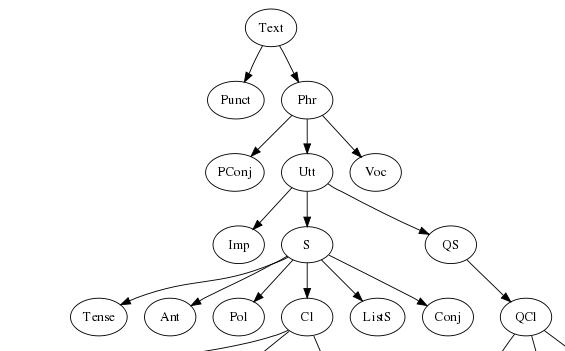
Prop = S
[Prop] = [S]
SimpleProp = MathCl = Cl ** {p:Polarity}
QProp = QS ;
Presenter Notes
Goal: Propositions
Prop = MathCl = Cl ** {p:Polarity}
[Prop] = [MathCl]
Prop --> S, QS
7 is prime.
is 7 prime?
[Prop] --> S, QS
7 is prime and 8 is not prime.
is it true that 7 is prime and 8 is not prime?
Presenter Notes
Transfers
"Compute the integral of the function mapping x to the square of x from minus infinity to infinity."
Compute Num (fromNum (
defint_interval (lambda x (power2 (Var2Num x)))
nums1_minus_infinity nums1_infinity))
Compute Num (fromNum (
defint_interval (lambda x (power2 (Var2Num x)))
(unary_minus nums1_infinity) nums1_infinity))
-
It is ambiguous? (not really)
-
power2-->power (int2num 2) (unary_minus nums1_infinity)-->nums1_minus_infinity
Presenter Notes
Transfers (2)
-
Modifying the abstract tree.
-
GF is very limited on this (
defjudgments). -
Use the GF bindings to other languages
- haskell
- python,
Presenter Notes
Transfer example
cat
Kind ;
Command;
Answer;
Value Kind;
Variable Kind ;
fun
Num, Fun, Set, Tensor : Kind ;
data Compute : (k: Kind) -> Value k -> Command ;
fun
addTo : ValNum -> ValNum -> Command ;
itNum : ValNum ;
itSet : ValSet ;
Simple : (k: Kind) -> Value k -> Answer ;
FeedBack : (k: Kind) -> Value k -> Value k -> Answer;
def
addTo x y = Compute Num (fromNum (plus (BaseValNum x y))) ;
bracket_emptyset = Simple Set (fromSet emptyset) ; -- {}
def
bin_over x y = divide x y ;
fun
isEqual : (k: Kind) -> Value k -> Value k-> Command ;
isAppEqual: (k: Kind) -> Value k -> Value k-> Command ;
Yes: Answer ;
No: Answer ;
YesApprox: Index -> Answer ;
Presenter Notes
In Haskell
1 completeEmpty :: Bool -> Tree -> Maybe Tree
2 completeReturn :: Bool -> Tree -> [Tree] -> [Tree]
3
4 completeEmpty False _ = Nothing
5 completeEmpty True question = Just $ gf $
6 case fg question of
7 GAssign k var value -> GAssigned k var value
8 GAssert p -> GAsserted p
9
10 completeReturn feedback question answers = catMaybes $ map (comp' . fg) answers
11 where
12 comp' = comp (fg question)
13 comp g a@(GYesApprox _) = Just (gf a)
14 comp g a@GNo = Just (gf a)
15 comp g a@GYes = Just (gf a)
16 comp g a@(GSimple k v2) =
17 case value g of
18 Just v1 -> Just $ gf $ if feedback
19 then (GFeedBack k v1 v2)
20 else a
21 _ -> Nothing
22 comp _ a@(GBegunBlock _) = Just (gf a)
23 comp _ a@(GEndedBlock _) = Just (gf a)
24 comp _ _ = Nothing
25 value (GCompute _ v) = Just v
26 value (GApproximate v) = Just $ GfromNum v
27 value (GApproximateTo v _) = Just $ GfromNum v
28 value _ = Nothing
Presenter Notes
Concluding remarks
-
The mgl GF library provides parsing/linearizing between 15 natural languages and an abstract representation similar to OpenMath.
- Tested for 3 languages.
-
It can be used to interact with mathematical software using natural language.
Presenter Notes
Developing a new language L
- Resource Grammar support
- Fill
LexiconL - Review cycle
- Fix idiomatic productions
Presenter Notes
Developing a new module M
- Add abstract module M
- Add entries to
LexiconLto support M - Add concrete modules for M
- Review cycle:
- Input from language + maths experts
Presenter Notes
Future work
-
Dependent types
-
Reduce indirection and simplify module structure
-
Mixtures
-
Qualified variables